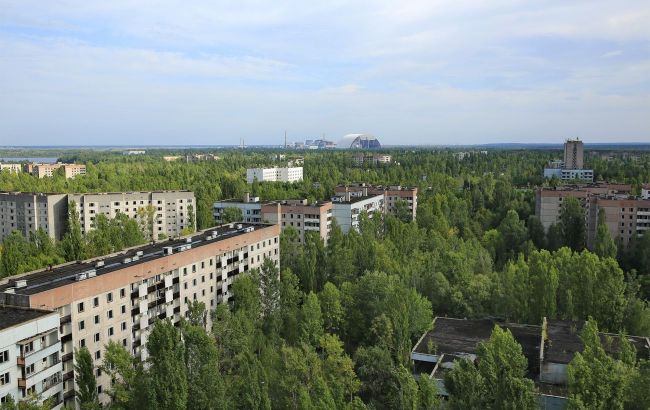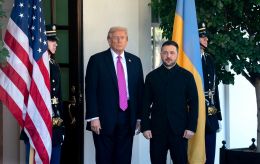The Independent claims that land around Chornobyl can be cultivated: Why this is not true
 Photo: Researchers reported that some Chornobyl lands are allegedly safe (Getty Images)
Photo: Researchers reported that some Chornobyl lands are allegedly safe (Getty Images)
The British outlet The Independent reported that most of the land in the Chornobyl zone has allegedly been deemed "suitable for agriculture." However, Ukrainian officials state that this information is inaccurate.
The Ministry of Environment and the State Agency of Ukraine on Exclusion Zone Management (SAUEZM) states this in a comment to RBC-Ukraine.
What The Independent reported
The Independent stated that a new study, the results of which were published in the Journal of Environmental Radioactivity, confirms the safety of growing agricultural crops on a significant portion of the Chornobyl Exclusion Zone.
The outlet claims that, as a result, Ukrainian farmland that had been taken out of use following the 1986 Chornobyl disaster has now been deemed suitable for agriculture.
Key points of the article:
-
The study outlines the development of an assessment protocol for abandoned land in Ukraine, based on a 100-hectare test site;
-
The transfer of radionuclides from soil to agricultural crops was evaluated for soil types typical of northern Ukraine;
-
A method was developed for rapid mapping of external radiation dose and radionuclide concentration on agricultural land;
-
A protocol was created to assess activity concentration in crops, milk, and meat, potentially enabling the return of land to agricultural use;
-
The developed protocol for assessing land contamination against regulatory limits was tested on a 100-hectare field research site.
Response from the Ministry of Environmental Protection and the State Agency for Environmental Protection (SAEP)
"Considering the above, it is generally incorrect to talk about recognizing lands that were removed from agricultural use after the Chernobyl disaster as suitable for farming," the Ministry of Environmental Protection and the SAEP said in response to an inquiry from RBC-Ukraine.
They also point out that the study referred to in the outlet mentions areas in the Zhytomyr region.
"It is important to emphasize that this territory is not the exclusion zone from which the population was evacuated in 1986," the statement reads.
Additionally, it is explained that the territory affected by radioactive contamination as a result of the Chernobyl disaster is divided into zones.
According to Article 2 of the Law of Ukraine On the Legal Regime of the Radioactively Contaminated Territories, the categories of radioactive contaminated areas are determined based on:
-
Landscape and geochemical characteristics of the soil,
-
The extent of radioactive contamination exceeding the natural pre-accident levels of radionuclide accumulation in the environment,
-
The associated potential negative impact on the health of the population,
-
Requirements for radiation protection of the population and other special measures,
-
General production and social-living relations.
Maps of the designated zones, lists of populated areas assigned to these zones, and data from annual dosimetric certification, including expected radiation exposure doses for the population, are published every three years in national and regional media and stored in the relevant central and local executive authorities.
At the same time, the Ministry of Environmental Protection and the State Agency of Ukraine on Exclusion Zone Management (SAUEZM) state that the Zhytomyr region includes: the zone of unconditional (mandatory) resettlement (Zone 2) and the zone of guaranteed voluntary resettlement (Zone 3).
Thus, in accordance with Article 12 of the Law of Ukraine On the Legal Regime of the Territory Contaminated as a Result of the Chornobyl Disaster, agricultural, forestry, industrial, or any other activities that do not meet radiation safety criteria are prohibited in the exclusion zone and the zone of unconditional (mandatory) resettlement without a special permit.
"The legal status of these zones cannot be changed without an official review procedure, and the conclusions of individual studies conducted on specific plots of land do not override legislative prohibitions," the Ministry and SAUEZM emphasized.
They also noted that in 2025, the government approved a decision (Resolution No. 111 dated January 31, 2025) to launch a new phase of dosimetric certification for settlements affected by radioactive contamination from the Chornobyl disaster.
"Starting from May 6, 2025, two mobile teams began fieldwork in the Zhytomyr region. These teams include dosimetrists, radiation monitoring specialists, observers, and representatives of local communities," the statement reads.
According to them, once sample collection is completed, all data will undergo laboratory analysis and be sent to the National Academy of Sciences for expert assessment (in accordance with the Procedure for Conducting Dosimetric Certification).
"Scientific research is always important and necessary. However, research findings should serve as an auxiliary tool for shaping state policy, not as a substitute for or cancellation of existing legislation," the Ministry and SAUEZM concluded.
Chornobyl disaster
The Chornobyl disaster occurred on the night of April 26, 1986.
It was caused by two thermal explosions at Reactor 4 of the Chornobyl Nuclear Power Plant (ChNPP), leading to partial destruction of the reactor and the release of a massive amount of radioactive substances into the environment. According to experts, this release was equivalent to several hundred Hiroshimas.
The explosion at the ChNPP reactor caused the largest uncontrolled release of radioactive materials into the environment in human history.
As a result of the disaster, approximately 5 million hectares of land were removed from agricultural use, and a 30-kilometer exclusion zone was established around the plant.
At present, a sarcophagus has been placed over the destroyed fourth reactor of the plant, which, incidentally, was damaged this year by a Russian drone attack.

